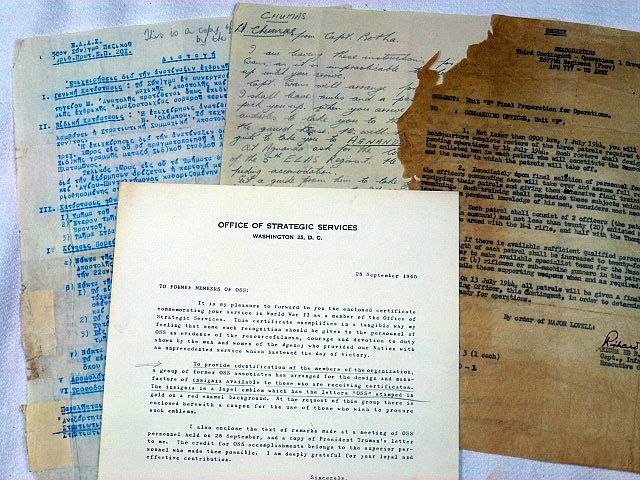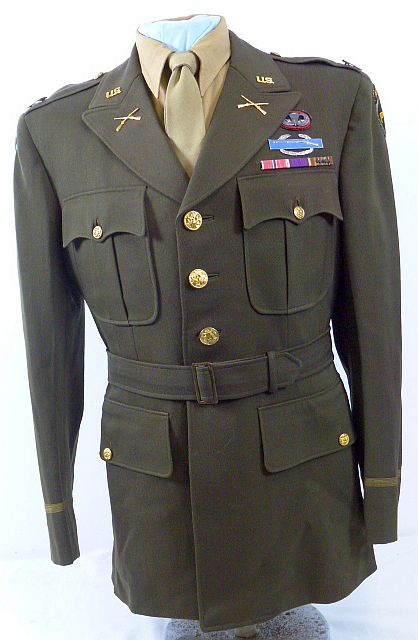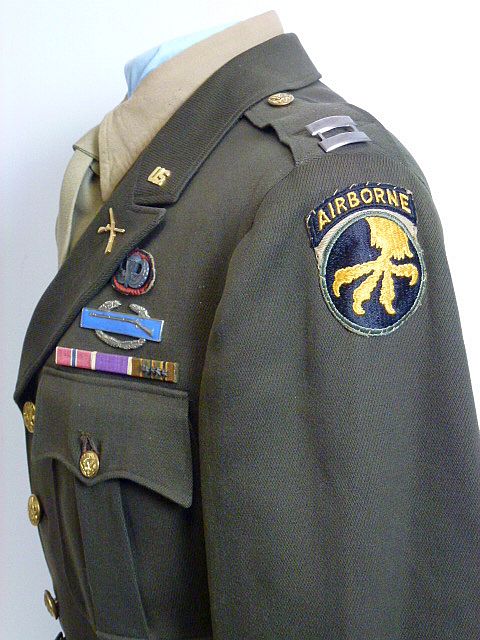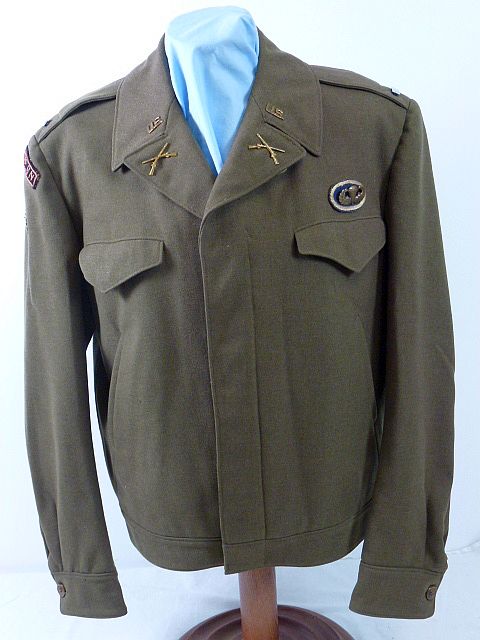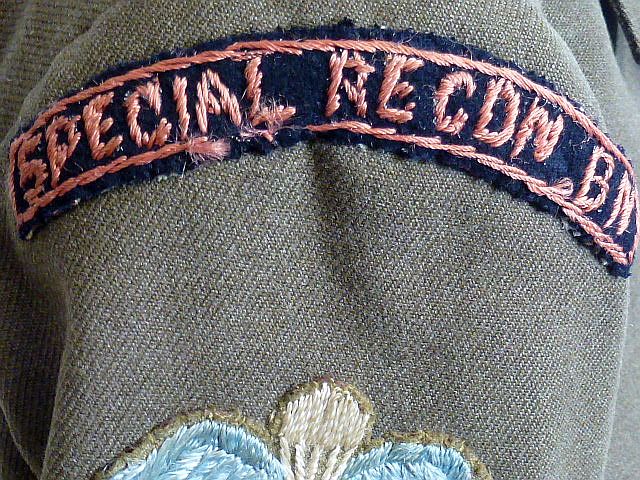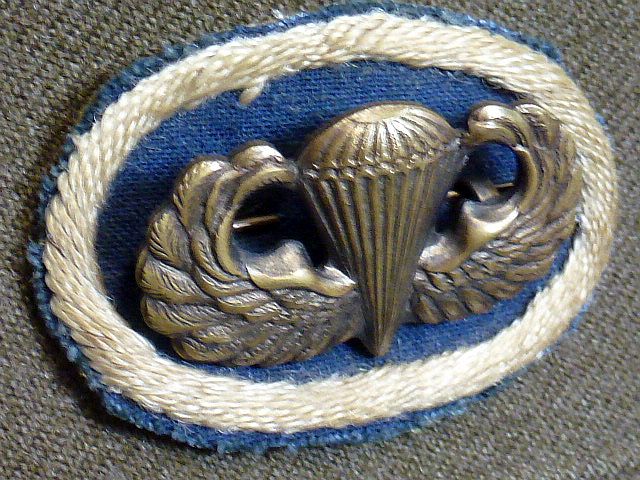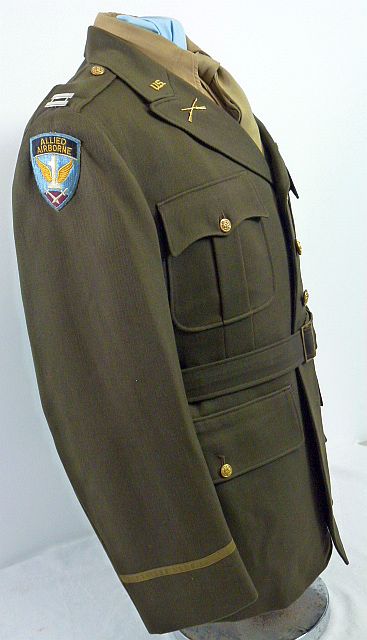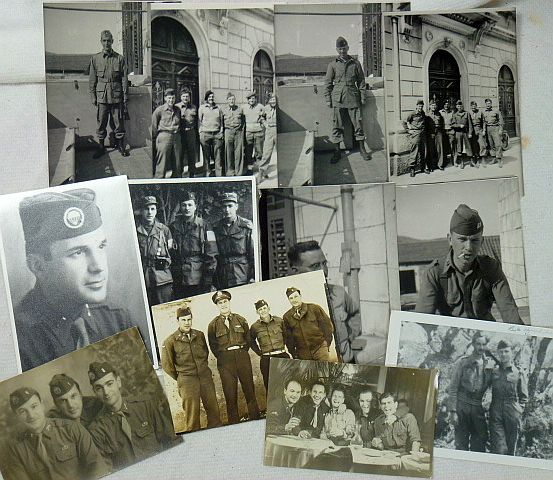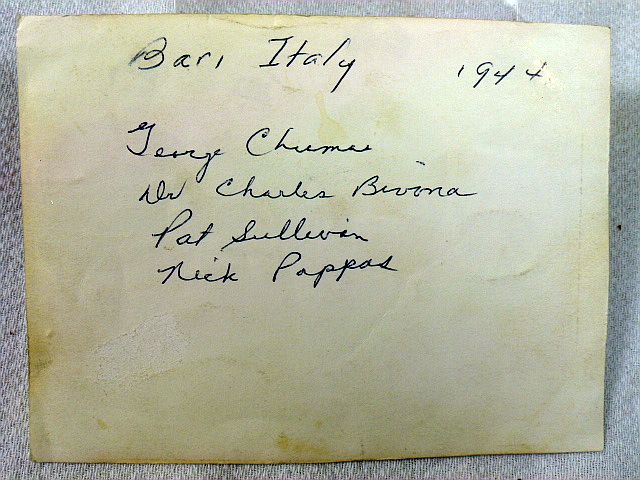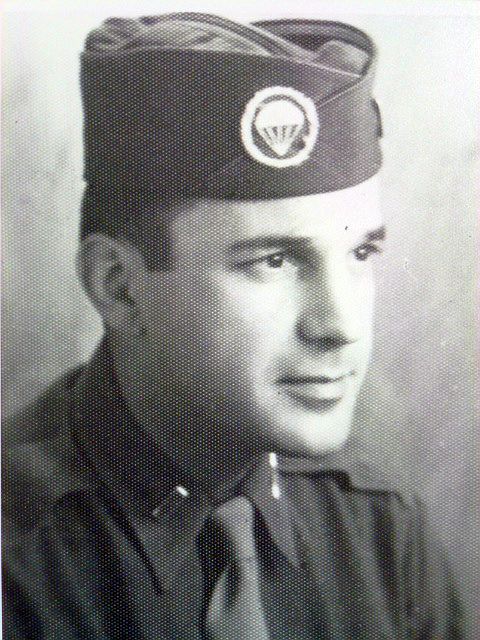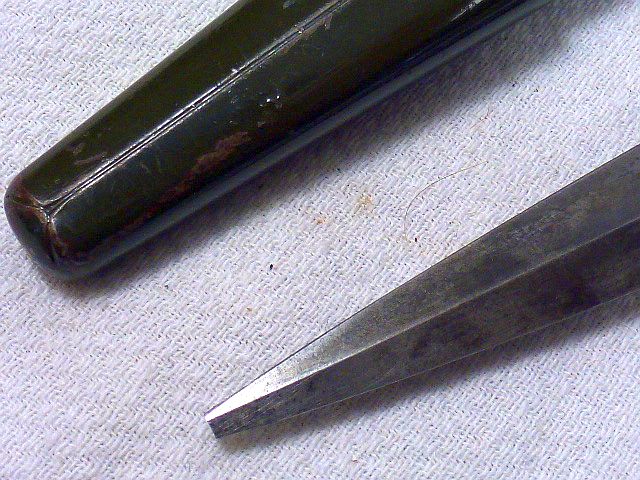Extraordinary Named OSS and Airborne Group
$6,850.00
A truly remarkable group comprised of the uniforms, medals, photographs, documents, and memorabilia of Captain George Chumas, who fought behind the lines in Greece as the commander of Operational Group VI of the 2671st Reconnaissance Battalion in the Office of Strategic Services and who, subsequently, fought as an officer of the 507th Parachute Infantry Regiment in the 17th Airborne Division.
The service of George Chumas could fill a book. It probably should be a book. This listing cannot relate all aspects of his remarkable service, and his combat experiences are certainly worthy of further research, particularly because much of the information relating to the service that he performed (leading behind the lines combatants in occupied Greece), was not declassified until 1988.
Very briefly, Chumas was a 20 year old Lieutenant in the Office of Strategic Services when, in July of 1944, he led Operational Group VI of the 2671st Special Reconnaissance Battalion of the OSS into Greece. Chumas and his group, like the other OSS operational groups that were fighting in Greece, waged a war that was designed to impede, in every way possible, the efforts of the Germans to withdraw their troops from Greece. The German withdrawals were an attempt to reinforce their front in France against the Allied forces that had been unleashed by the D-Day invasion. The OSS Operational Groups in Greece focused heavily on attacking the German trains and rail lines that were vital in the Third Reich’s strategy to move troops and materiel to the west. The documents included in this group, as well as declassified materials now available in the National Archives and on line, provide the details of the missions of the OSS groups. Frequently Chumas and his team moved from their mountain location to the rail lines that were their targets. Demolition charges were laid. When the enemy train approached, the locomotive was hit with a rocket from a bazooka, while the train itself was raked with fire from machine guns and BAR’s. The demolition charges were detonated. Enemy troops were engaged and, upon completion of the mission, the OSS Operational Group would withdraw to regroup and plan their next attacks. When the Germans were ultimately defeated in Greece, OSS personnel such as Chumas were withdrawn and reassigned. Chumas then served in combat with the 507th P.I.R. in western Europe.
This extensive group is comprised of the following items:
Uniforms:
– WWII Army officer B-13 jacket, a garment that was popular with OSS personnel. In fact, this group includes an original 1944 photograph taken in Italy that shows Chumas and three other OSS officers and in the photograph Chumas is wearing this jacket, while another officer in the group also wears a B-13 jacket. This jacket looks very much like the standard Eisenhower jacket but has the two lined slash pockets on the front. The lapels display officer’s insignia of crossed rifles and “U.S.” devices. On the left breast is a theater-made airborne oval, royal blue in color with a white border, the oval that was worn by the 2671st Reconnaissance Battalion of the OSS. The oval is secured to the jacket by a theater-made paratrooper wing. On the right shoulder is a theater-made arc for the “Special Recon. Bn.” which was worn by the personnel of the 2671st Special Reconnaissance Battalion of the OSS. Beneath the arc is a theater-made British paratrooper wing. Inside of the breast pocket of the jacket is written in ink: “Chumas 861″ (Chumas’ full service number was 01324861). The jacket is extremely clean, with no significant wear aside from expected field use.
– Chumas’ Class A uniform: The uniform consists of a chocolate officer’s jacket and pink trousers. Both the jacket and the trousers have the tailor label of Smith-Gray in New York City. Both of the labels are dated in August of 1943, and both labels have George Chumas’ name typed on the label as the owner. The jacket has a typed size of 41. The trousers also have”Lt. Chumas” and “4861” handwritten inside, which would have been the numbers used by Chumas as a laundry mark. The belted four pocket jacket has crossed infantry officer’s rifles and “U.S.” collar devices and pin back Captain’s bars on the shoulders. On the top of the left sleeve is the shoulder patch of the 17th Airborne Division, this example being a version with the talon patch and the “Airborne” tab connected by khaki colored cloth. On the right shoulder is a U.S.-made example of the “Allied Airborne” shoulder patch. The left chest has a clutch back ribbon bar with ribbons for the Bronze Star, the Purple Heart, and the European Campaign Medal with four campaign stars and an arrowhead device. Above the ribbon bar is a clutch back Combat Infantry Badge and, above that, a theater-made parachute badge oval for the 507th Parachute Infantry Regiment. The oval is secured to the jacket by the pin of a sterling paratrooper wing that is maker marked by AE Co. The Class A uniform of Captain Chumas is completed by the presence of Chumas’ khaki colored officer’s shirt and khaki necktie. The shirt is noteworthy in that on the left shoulder it has the same one-piece style patch of the 17th Airborne Division, with connecting khaki cloth between the patch and tab, that is found on the jacket. The right shoulder of the officer’s shirt has a British-made “Allied Airborne” shoulder patch. The class A uniform is in excellent condition, with only some evidence of wear in the collar of the shirt.
– Service uniform: Captain Chumas’ service uniform consists of an olive green wool shirt and olive green wool trousers. The shirt has a tag attached inside of it that bears Chumas’ laundry mark of C-4861. It is tagged as a size 15 1/2-32. It has one very small hole in the upper back, which is smaller than the head of a pencil eraser. The trousers and the shirt are both in very fine condition.
Caps:
– The group includes two officer overseas caps that belonged to Chumas. One is a dark olive wool, with officer piping and a patch on the front for an officer of glider borne airborne troops (although Chumas himself was a paratrooper). On the opposite side of the cap is a pair of pin back Captain”s bars. The second overseas cap is more of the “chocolate” color. Interestingly, although it is obviously an officer quality cap with officer black and gold piping, the front of the cap has the patch that is commonly referred to as the “enlisted” version of paraglider troops, with the glider facing the viewer’s left. Both of the caps show wear, the olive example more so than the chocolate example, but both caps are in very good used condition.
Decorations and Medals:
– The group includes Chumas’ Bronze Star decoration, slot brooch, unnamed as awarded in the theater of operations, in titled leather case with lapel badge; Purple Heart decoration, slot brooch, unnamed as awarded in the theater of operations, in titled leather case with lapel badge; European Campaign Medal, crimp brooch, in Medallic Art box; and World War II Victory Medal, crimp brooch.
OSS Fighting Knife:
– A fine, used example of the OSS fighting knife with the original “Pancake flipper” scabbard from Landers, Frary & Clark. The very tip of the knife blade was broken (Well, after all, it was intended to be used as a “combat knife”). The blade has some areas of discoloration, and the top of the leather scabbard has come loose from the “Flapper”, although the rivet that connected the flapper to the scabbard is still in place and connected to the flapper; the rivet has simply come out of the leather scabbard.
Photographs:
– The group includes 12 black and white photographs of various sizes that show Chumas and his OSS colleagues during the war and two officers in particular: Nick Pappas and Mike Manusos. Three of the photographs are original, World War II period photos, one of which is identified on the back as having been taken in Bari, Italy, in 1944. The four men in the photo are identified as George Chumas, Dr. Charles Buona, Pat Sullivan, and Nick Pappas. In this photograph Chumas wears the B-13 jacket that is a part of this group, with the British airborne wing visible on the sleeve. Evidently he had not yet added the “Special Recon. Bn.” arc to the jacket when the photograph was taken. Of the 12 photographs, all of them except one have notations on the back that identify some or all of the individuals in the pictures.
Documents:
– The Chumas group includes two binders with documentation, both original period documents, and photocopies of material on the OSS operations reports from Greece. Some of the original documents in the group include the following materials:
– Letter dated 28 September, 1945, from the Office of Strategic Services, enclosing a large certificate attesting to service in the OSS. The document is 8 1/4 by 10 3/4 and bears the name of “First Lieutenant George Chumas”.
– Original document, typed in Greek, with the pencil notation “This is a copy off the order issued by the Regt. about the operation.”
– Several handwritten messages that were apparently written for Chumas in Greece by his commanding officer regarding actions that he was to take with his group.
– Multiple handwritten documents in Greek that presumably relate to the actions of Chumas’ group.
Books:
There are two books with the group:
– “Case Study in Guerrilla War: Greece During World War II”, hardcover, by D.M. Condit, published in 1961 by the Special Operations Research Office of The American University. This was apparently the Ph.D. thesis of the author; and
– “Yannis”, by John (Yannis) Giannaris, published 1988 by Pilgrimage Publishing. Hardcover, with dust jacket. The author was. like Chumas, a member o the OSS detachment that ought a guerrilla war in Greece.
In summary, the group of George Chumas constitutes an extraordinary assemblage of material from a solider who served as both a covert operations officer of the OSS, and as a paratrooper officer in a noted combat airborne division, during the Second World War. In terms of the sheer extent of its content, the rarity of its components, the condition of the items, and the historical significance of the material, the grouping of Captain George Chumas is nothing short of extraordinary, and there are likely few such groups in private or public collections that could rival it.
Sold!


